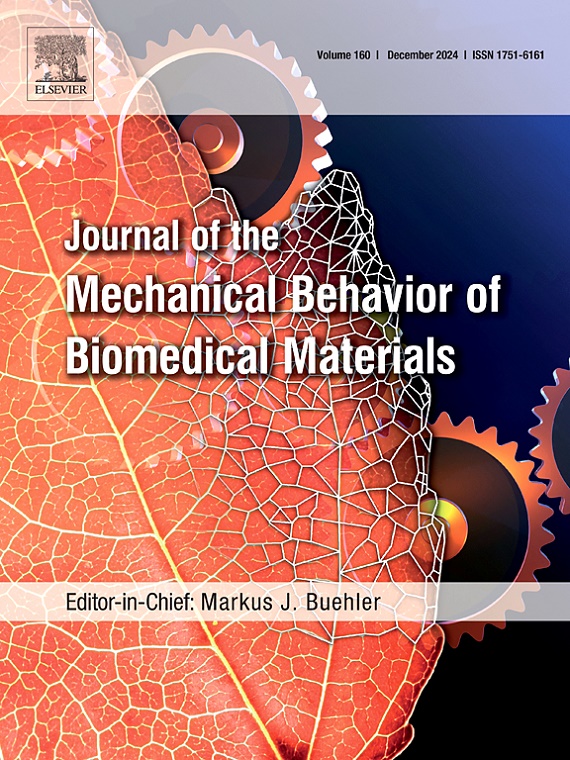皮肤表面基于应变的生物标志物可区分与肌筋膜疼痛相关的软组织活动不对称
IF 3.5
2区 医学
Q2 ENGINEERING, BIOMEDICAL
Journal of the Mechanical Behavior of Biomedical Materials
Pub Date : 2025-08-31
DOI:10.1016/j.jmbbm.2025.107175
引用次数: 0
摘要
软组织操作被广泛用于定性评估肌筋膜组织,但缺乏客观的测量方法。为了量化肌筋膜组织的流动性,这项工作从皮肤表面提取光学生物标志物,正如临床医生在实际工作流程中观察到的那样。当临床医生深度接触和拉伸皮肤和肌筋膜组织时,使用三个高分辨率摄像机的数字图像相关捕获颈胸区域。19名参与者被放置在俯卧位置,并标记上半永久性纹身,这是为了在不损害组织自然力学的情况下跟踪组织而优化的。然后临床评估双侧(身体左侧和右侧)和方向(上拉和下拉方向)的组织活动性。每次组织牵拉得到11个基于菌株的生物标志物。综合参与者的数据,身体的两侧是模糊的,尽管向上和向下方向的拉力是不同的。考虑到参与者之间生物标志物绝对值的巨大差异,我们随后对每个人进行了单独评估。其中,观察到明显的组织行为。特别是,在9名参与者中发现了双边差异,其中8人报告了左右两侧疼痛的差异,而在16名参与者中观察到方向性差异,正如预期的那样,个体之间的解剖组织结构相似。在我们的参与者样本中,光学皮肤表面跟踪和衍生的基于应变的生物标志物确定了双侧活动的不对称差异,这与自我报告的疼痛相对应。这种对肌筋膜组织僵硬度的客观评估对于监测和治疗慢性肌肉骨骼疼痛非常重要,这种疼痛折磨着一半的美国成年人。本文章由计算机程序翻译,如有差异,请以英文原文为准。

Strain-based biomarkers at the skin surface differentiate asymmetries in soft tissue mobility associated with myofascial pain
Soft tissue manipulation is used widely to assess myofascial tissue qualitatively but lacks objective measures. To quantify the mobility of myofascial tissue, this effort derives optical biomarkers from the skin surface, as observed in the hands-on workflow of clinicians. Digital image correlation using three high-resolution cameras captures the cervicothoracic region as a clinician deeply engages and stretches the skin and myofascial tissue. Nineteen participants were positioned prone and marked with semi-permanent tattoos, optimized for tracking tissue without compromising its natural mechanics. Tissue mobility was then clinically assessed both bilaterally (left and right sides of body) and directionally (superior and inferior directions of pull). Eleven strain-based biomarkers were derived per tissue pull. With participants' data aggregated, the sides of the body were indistinct, though pull in the superior direction was distinct from that in the inferior direction. Given substantial variance in the biomarkers’ absolute values between participants, we then evaluated each person individually. Therein, distinct tissue behaviors were observed. In particular, bilateral differences were identified in nine participants, eight of whom reported discrepancies in pain between their left and right sides, while directional distinctions were observed in sixteen participants, as expected given similar anatomical tissue structures between individuals. In our sample of participants, optical skin surface tracking and derived strain-based biomarkers identified asymmetrical distinctions in bilateral mobility, which correspond with self-reported pain. Such objective assessment of myofascial tissue stiffness is important in monitoring and treating chronic musculoskeletal pain, which afflicts half of the U.S. adult population.
求助全文
通过发布文献求助,成功后即可免费获取论文全文。
去求助
来源期刊

Journal of the Mechanical Behavior of Biomedical Materials
工程技术-材料科学:生物材料
CiteScore
7.20
自引率
7.70%
发文量
505
审稿时长
46 days
期刊介绍:
The Journal of the Mechanical Behavior of Biomedical Materials is concerned with the mechanical deformation, damage and failure under applied forces, of biological material (at the tissue, cellular and molecular levels) and of biomaterials, i.e. those materials which are designed to mimic or replace biological materials.
The primary focus of the journal is the synthesis of materials science, biology, and medical and dental science. Reports of fundamental scientific investigations are welcome, as are articles concerned with the practical application of materials in medical devices. Both experimental and theoretical work is of interest; theoretical papers will normally include comparison of predictions with experimental data, though we recognize that this may not always be appropriate. The journal also publishes technical notes concerned with emerging experimental or theoretical techniques, letters to the editor and, by invitation, review articles and papers describing existing techniques for the benefit of an interdisciplinary readership.
 求助内容:
求助内容: 应助结果提醒方式:
应助结果提醒方式:


